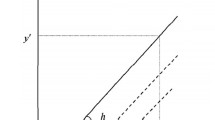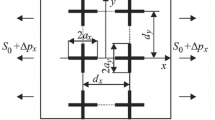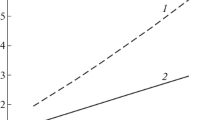A model describing crack length distribution is proposed on the basis of experimental laws governing the formation and growth of fatigue cracks in a flat specimen with multiple stress raisers. The density of this distribution corresponds to that of Pareto and can be used to describe the accumulation of scattered defects in a wide range of cracking scale. The critical values of Pareto distribution exponent, which correspond to the limit states of the multiple fracture of solid bodies, have been substantiated.






Similar content being viewed by others
References
L. R. Botvina and G. I. Barenblatt, “Self-similarity of damage cumulation,” Strength Mater., 17, No. 12, 1653–1663 (1985).
L. R. Botvina, Fracture Kinetics of Structural Materials [in Russian], Nauka, Moscow (1989).
L. R. Botvina, Fracture: Kinetics, Mechanisms, General Laws [in Russian], Nauka, Moscow (2008).
A. Carpinteri, G. Lacidogna, and S. Puzzi, “Prediction of cracking evolution in full scale structures by the b-value analysis and Yule statistics,” Fiz. Mesomekh., 11, No. 3, 75–87 (2008).
V. V. Bolotin, Life of Machines and Structures [in Russian], Mashinostroenie, Moscow (1990).
S. R. Ignatovich and N. I. Bouraou, “The reliability of detecting cracks during nondestructive testing of aircraft components,” Russ. J. Nondestruct. Test., 49, No. 5, 294–300 (2013).
S. R. Ignatovich, “Predicting the merging of disperse defects,” Strength Mater., 24, No. 2, 202–211 (1992).
S. R. Ignatovich, A. G. Kucher, A. S. Yakushenko, and A. V. Bashta, “Modeling of coalescence of dispersed surface cracks. Part 1. Probabilistic model for crack coalescence,” Strength Mater., 36, No. 2, 125–133 (2004).
S. R. Ignatovich, “Probabilistic model of multiple-site fatigue damage of riveting in airframes,” Strength Mater., 46, No. 3, 336–344 (2014).
S. R. Ignatovich and E. V. Karan, “Fatigue crack growth kinetics in D16AT aluminum alloy specimens with multiple stress concentrators,” Strength Mater., 47, No. 4, 586–594 (2015).
V. T. Troshchenko and L. A. Khamaza, Mechanics of Nonlocalized Fatigue Damage of Metals and Alloys [in Russian], Pisarenko Institute of Problems of Strength, National Academy of Sciences of Ukraine, Kiev (2016).
S. Barter, L. Molent, N. Goldsmith, and R. Jones, “An experimental evaluation of fatigue crack growth,” Eng. Fail. Anal., 12, 99–128 (2005).
L. Molent, R. Jones, S. Barter, and S. Pitt, “Recent developments in fatigue crack growth assessment,” Int. J. Fatigue, 28, 1759–1768 (2006).
D. A. Virkler, B. M. Hillberry, and P. K. Goel, “The statistical nature of fatigue crack propagation,” J. Eng. Mater. Technol., 101, No. 2, 148–153 (1979).
Y. C. Tong, Literature Review on Aircraft Structural Risk and Reliability Analysis, Technical Report DSTO-TR-1110, Aeronautical and Maritime Research Laboratory (2001).
S. R. Ignatovich, E. V. Karan, and V. S. Krasnopol’skii, “Crack length distribution in a riveted joint of on aircraft structure in the case of multiple site damage,” Fiz.-Khim. Mekh. Mater., 49, No. 2, 109–116 (2013).
S. R. Ignatovich, “Distribution of defect dimensions in loading solids,” Strength Mater., 22, No. 9, 1295–1301 (1990).
I. S. Gradshtein and I. M. Ryzhik, Tables of Integrals, Sums, Series, and Products [in Russian], Nauka, Moscow (1971).
M. E. J. Newman, “Power laws, Pareto distributions and Zipf’s law,” Contemp. Phys., 46, No. 5, 323–351 (2005).
V. A. Vladimirov, Yu. L. Vorob’ev, G. G. Malinetskii, et al., Risk Control. Risk, Sustainable Development, and Synergetics [in Russian], Nauka, Moscow (2000).
A. Carpinteri, G. Lacidogna, G. Niccolini, and S. Puzzi, “Critical defect size distributions in concrete structures detected by the acoustic emission technique,” Meccanica, 43, 349–363 (2008).
Author information
Authors and Affiliations
Corresponding author
Additional information
Translated from Problemy Prochnosti, No. 6, pp. 31 – 42, November – December, 2017.
Rights and permissions
About this article
Cite this article
Ignatovich, S.R., Krasnopol’skii, V.S. Probabilistic Distribution of Crack Length in the Case of Multiple Fracture. Strength Mater 49, 760–768 (2017). https://doi.org/10.1007/s11223-018-9921-9
Received:
Published:
Issue Date:
DOI: https://doi.org/10.1007/s11223-018-9921-9




